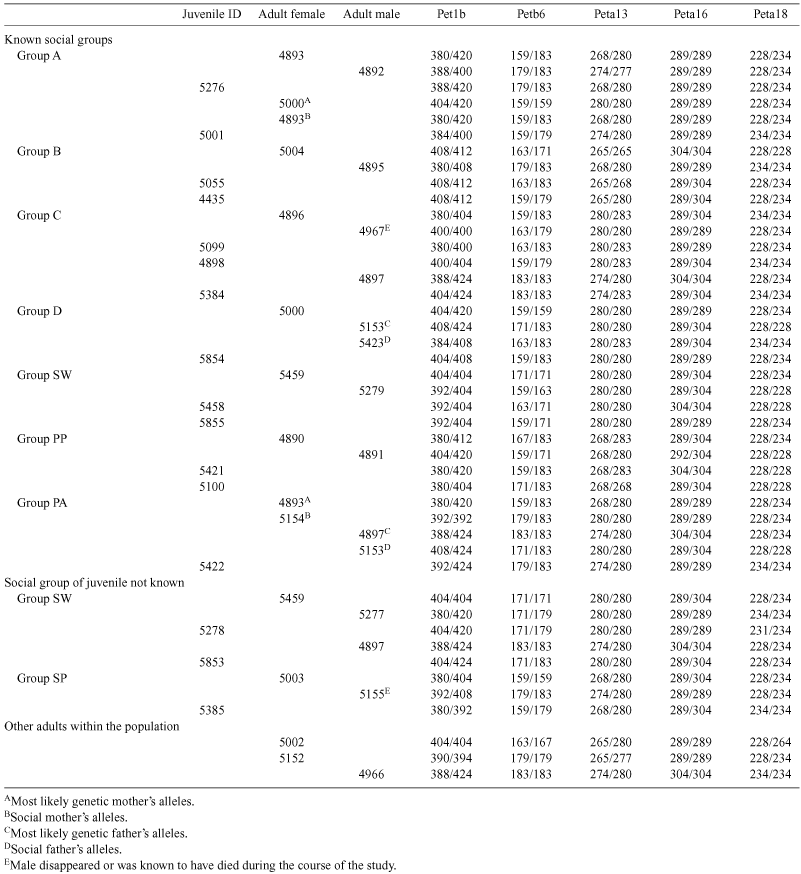Monogamy in an Australian arboreal marsupial, the yellow-bellied glider (Petaurus australis)
Meredeth Brown A B , Susan M. Carthew A and Steven J. B. Cooper B C DA School of Earth and Environmental Sciences, The University of Adelaide, DP312, Adelaide, SA 5005, Australia.
B Evolutionary Biology Unit, South Australian Museum, North Terrace, Adelaide, SA 5000, Australia.
C Australian Centre for Evolutionary Biology and Biodiversity, The University of Adelaide, SA 5000, Australia.
D Corresponding author. Email: cooper.steve@saugov.sa.gov.au
Australian Journal of Zoology 55(3) 185-195 https://doi.org/10.1071/ZO07027
Submitted: 15 April 2006 Accepted: 11 May 2007 Published: 28 June 2007
Abstract
Several Australian arboreal marsupials have been reported to show variation in mating system across populations, but most previous studies have not included genetic analyses to confirm the observations. Our aim was to test the hypothesis that monogamy was the predominant mating system in a population of yellow-bellied gliders (Petaurus australis) in south-western Victoria, using a combination of behavioural observations and molecular genetic analyses. Home-range overlap, cohesiveness of pairs, rates of den site co-occupancy and location of den trees within the home ranges of 13 adult gliders were determined via radio-tracking. A monogamous social system predominated, demonstrated by extensive home-range overlap between cohabiting adult males and females (40–100%) and little home-range overlap between adjacent territories (<14%). Males spent ~55% of their active time within 25 m of their female partners and 55–85% of their sleeping time in dens with their female partner. The parentage of all juveniles spotlighted within the 400-ha study area was analysed using five microsatellite DNA markers. Of 37 individuals genotyped, eight of 13 juveniles were assigned both social parents as true parents with ≥80% confidence. These results suggest that social and genetic monogamy predominated in this population of yellow-bellied gliders.
Acknowledgements
This research was supported by funding from a University Research Grant, Mark Mitchell Foundation, Nature Foundation, The Department of Environment and Heritage (Wildlife Conservation Fund), Hancock Victorian Timber Plantations, the Royal Zoological Society of South Australia/Rotary Robin Fund and The University of Adelaide. We thank numerous volunteers for their assistance in the field, particularly D. Funnell, G. Williamson, A. McIlwee, K. Richardson, S. Mason and A. Rapacz. K. Saint and T. Bertozzi, SA Museum, are thanked for technical assistance in the laboratory. Field and laboratory work was carried out under Animal Ethics W-13-2002 and W-10-99, DSE permit numbers 10001364, 10001803 and 10002392. Our reviewers are thanked for their extremely helpful and insightful comments.
Börger, L. , Franconi, N. , de Michele, G. , Gantz, A. , Meschi, F. , Manica, A. , Lovari, S. , and Coulson, T. (2006). Effects of sampling regime on the mean and variance of home range size estimates. Journal of Animal Ecology 75, 1393–1405.
| Crossref | GoogleScholarGoogle Scholar | PubMed |
Brotherton, P. N. M. , Pemberton, J. M. , Komers, P. E. , and Malarky, G. (1997). Genetic and behavioural evidence of monogamy in a mammal, Kirk’s dik-dik (Madoqua kirkii). Proceedings of the Royal Society of London. Series B. Biological Sciences 264, 675–681.
| Crossref | GoogleScholarGoogle Scholar |
Brown, M. , Kendal, T. A. , Cooksley, H. , Saint, K. M. , Taylor, A. C. , Carthew, S. M. , and Cooper, S. J. B. (2004). Polymorphic microsatellite markers for the gliding marsupials Petaurus australis and Petaurus breviceps. Molecular Ecology Notes 4, 704–706.
| Crossref | GoogleScholarGoogle Scholar |
Goldingay, R. L. (1989b). Time budget and related aspects of the foraging behaviour of the yellow-bellied glider, Petaurus australis. Australian Wildlife Research 16, 105–112.
| Crossref | GoogleScholarGoogle Scholar |
Jackson, S. M. (2000). Home-range and den use of the mahogany glider (Petaurus gracilis). Wildlife Research 27, 49–60.
| Crossref | GoogleScholarGoogle Scholar |
Mathews, L. M. (2002a). Territorial cooperation and social monogamy: factors affecting intersexual behaviours in pair-living snapping shrimp. Animal Behaviour 63, 767–777.
| Crossref | GoogleScholarGoogle Scholar |
Rutberg, A. T. (1983). The evolution of monogamy in primates. Journal of Theoretical Biology 104, 93–112.
| Crossref | GoogleScholarGoogle Scholar | PubMed |
Wallander, J. , Blomqvist, D. , and Lifjeld, J. T. (2001). Genetic and social monogamy – does it occur without mate guarding in the ringed plover? Ethology 107, 561–572.
| Crossref | GoogleScholarGoogle Scholar |

Wittenberger, J. F. , and Tilson, R. L. (1980). The evolution of monogamy: hypotheses and evidence. Annual Review of Ecology and Systematics 11, 197–232.
| Crossref | GoogleScholarGoogle Scholar |

Worton, B. J. (1987). A review of models of home range for animal movement. Ecological Modelling 38, 277–298.
| Crossref | GoogleScholarGoogle Scholar |

Worton, B. J. (1989). Kernel methods for estimating the utilization distribution in home-range studies. Ecology 70, 164–168.
| Crossref | GoogleScholarGoogle Scholar |


|


